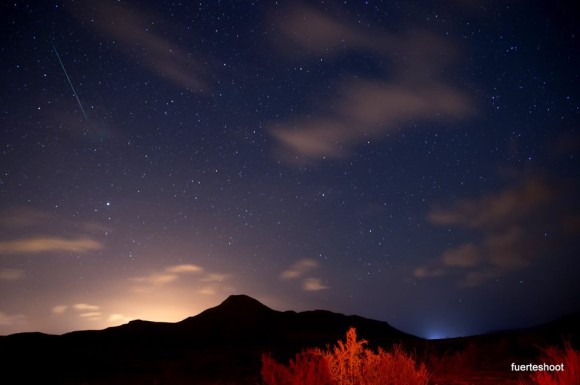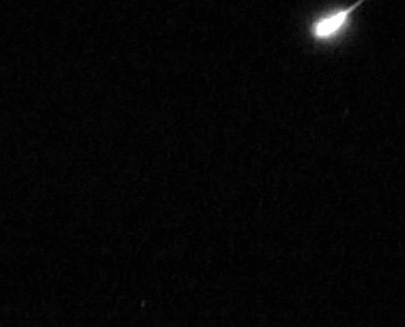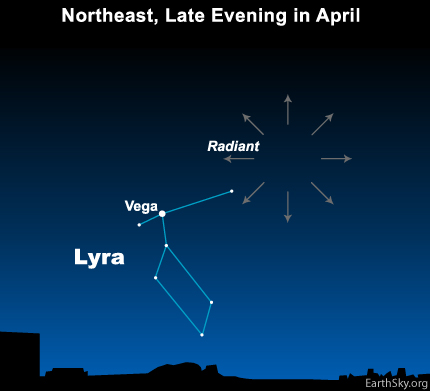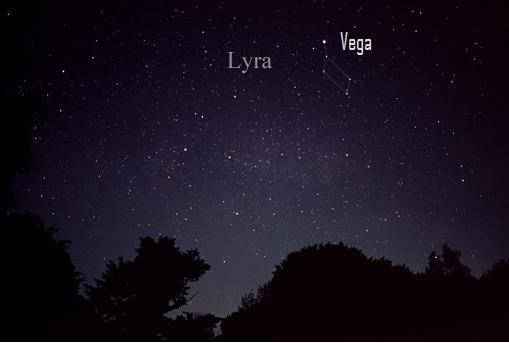

Composite image of Lyrid and not-Lyrid meteors over New Mexico from April, 2012. Image via NASA/ MSFC/ Danielle Moser.
The annual Lyrid meteor shower is starting! It’s active each year from about April 16 to 25. In 2018, the peak of this shower – which tends to come in a burst and usually lasts for less than a day – is expected to fall on the morning of April 22, with little or no interference from the waxing moon.
No matter where you are on Earth, expect the greatest number of meteors to fall during the few hours before dawn.
All in all the Lyrid meteor shower prospects look pretty good for 2018, though meteor showers are notorious for being fickle and not totally predictable.

View larger. | Simon Waldram in the Canary Islands caught this Lyrid meteor in April, 2014.
In a moonless sky, you might see from about 10 to 20 Lyrid meteors an hour at the shower’s peak on the morning of April 22. In 2018, the waxing moon will set before the primetime morning hours.
Those predicted maxima assume you are watching in a dark, country sky.

A fireball meteor falling earthward, courtesy of NASA/ George Varros.
An outburst of Lyrid meteors is always a possibility, too, though no Lyrid outburst is predicted for 2018.
In 1982, American observers did see an outburst of nearly 100 Lyrid meteors per hour. Around 100 meteors per hour were seen in Greece in 1922 and from Japan in 1945.
If you see a meteor … notice whether it leaves a persistent train – that is, an ionized gas trail that glows for a few seconds after the meteor has passed. About a quarter of Lyrid meteors do leave persistent trains.

The radiant point of the Lyrid meteor shower is near the bright star Vega in the constellation Lyra the Harp.
If you trace the paths of all the Lyrid meteors backward, they seem to radiate from the constellation Lyra the Harp, near the brilliant star Vega. This is only a chance alignment, for these meteors burn up in the atmosphere about 60 miles (100 km) up. Meanwhile, Vega lies trillions of times farther away at 25 light-years.
Yet it’s from Vega’s constellation Lyra that the Lyrid meteor shower takes its name.

Another view of the brilliant star Vega, which nearly coincides with the radiant point of April’s Lyrid meteor shower. Image via AlltheSky.
It’s not true you need to recognize a meteor shower’s radiant point in order to see any meteors. You don’t need to identify Vega or its constellation Lyra in order to watch the Lyrid meteor shower. Any meteors visible the sky will likely appear unexpectedly, in any and all parts of the sky.
However, knowing the rising time of the radiant point helps you know when the shower is best in your sky. The higher Vega climbs into your sky, the more meteors you’re likely to see. Be aware that the star Vega resides quite far north of the celestial equator, so for that reason the Lyrid meteor shower favors the Northern Hemisphere.
Around the Lyrids’ peak, the star Vega rises above your local horizon – in the northeast – around 9 to 10 p.m. local time (that’s the time on your clock, from Northern Hemisphere locations). It climbs upward through the night. By midnight, Vega is high enough in the sky that meteors radiating from her direction streak across your sky.
Just before dawn, Vega and the radiant point shine high overhead. That’s one reason the meteors are always more numerous before dawn.

Portrait of Confucius.[/a]
The Lyrid meteor shower has the distinction of being among the oldest of known meteor showers. Records of this shower go back for some 2,700 years.
The ancient Chinese are said to have observed the Lyrid meteors falling like rain in the year 687 BC.
That time period in ancient China, by the way, corresponds with what is called the Spring and Autumn Period (about 771 to 476 BC), which tradition associates with the Chinese teacher and philosopher Confucius, one of the first to espouse the principle:
Do not do to others what you do not want done to yourself.
I wonder if Confucius saw any Lyrid meteors …
[caption id="attachment_260398" align="aligncenter" width="800"] Comet Thatcher on January 1, 1861, the year of its last (and only) observed return. Image via JPL Small-Body Database.
Comet Thatcher on January 1, 1861, the year of its last (and only) observed return. Image via JPL Small-Body Database.
Comet Thatcher (C/1861 G1) is the source of the Lyrid meteors. Every year, in late April, our planet Earth crosses the orbital path of this comet. We have no photos of it because its orbit around the sun is roughly 415 years. Comet Thatcher last visited the inner solar system in 1861, before the photographic process became widespread. This comet isn’t expected to return until the year 2276.
Bits and pieces shed by this comet litter its orbit and bombard the Earth’s upper atmosphere at 110,000 miles (177,000 km ) per hour. The vaporizing debris streaks the nighttime with medium-fast Lyrid meteors.
It’s when Earth passes through an unusually thick clump of comet rubble that an elevated number of meteors can be seen.
Bottom line: The Lyrid meteor shower offers 10 to 20 meteors per hour at its peak on a moonless night. The peak numbers are expected to fall on the morning of April 22, 2018. Try watching on April 21 and 23, too. The light of the waxing moon won’t greatly interfere with 2018’s Lyrid shower, because it’ll set before the peak viewing hours.
EarthSky’s meteor shower guide for 2018
from EarthSky https://ift.tt/1cAVi2W


Composite image of Lyrid and not-Lyrid meteors over New Mexico from April, 2012. Image via NASA/ MSFC/ Danielle Moser.
The annual Lyrid meteor shower is starting! It’s active each year from about April 16 to 25. In 2018, the peak of this shower – which tends to come in a burst and usually lasts for less than a day – is expected to fall on the morning of April 22, with little or no interference from the waxing moon.
No matter where you are on Earth, expect the greatest number of meteors to fall during the few hours before dawn.
All in all the Lyrid meteor shower prospects look pretty good for 2018, though meteor showers are notorious for being fickle and not totally predictable.

View larger. | Simon Waldram in the Canary Islands caught this Lyrid meteor in April, 2014.
In a moonless sky, you might see from about 10 to 20 Lyrid meteors an hour at the shower’s peak on the morning of April 22. In 2018, the waxing moon will set before the primetime morning hours.
Those predicted maxima assume you are watching in a dark, country sky.

A fireball meteor falling earthward, courtesy of NASA/ George Varros.
An outburst of Lyrid meteors is always a possibility, too, though no Lyrid outburst is predicted for 2018.
In 1982, American observers did see an outburst of nearly 100 Lyrid meteors per hour. Around 100 meteors per hour were seen in Greece in 1922 and from Japan in 1945.
If you see a meteor … notice whether it leaves a persistent train – that is, an ionized gas trail that glows for a few seconds after the meteor has passed. About a quarter of Lyrid meteors do leave persistent trains.

The radiant point of the Lyrid meteor shower is near the bright star Vega in the constellation Lyra the Harp.
If you trace the paths of all the Lyrid meteors backward, they seem to radiate from the constellation Lyra the Harp, near the brilliant star Vega. This is only a chance alignment, for these meteors burn up in the atmosphere about 60 miles (100 km) up. Meanwhile, Vega lies trillions of times farther away at 25 light-years.
Yet it’s from Vega’s constellation Lyra that the Lyrid meteor shower takes its name.

Another view of the brilliant star Vega, which nearly coincides with the radiant point of April’s Lyrid meteor shower. Image via AlltheSky.
It’s not true you need to recognize a meteor shower’s radiant point in order to see any meteors. You don’t need to identify Vega or its constellation Lyra in order to watch the Lyrid meteor shower. Any meteors visible the sky will likely appear unexpectedly, in any and all parts of the sky.
However, knowing the rising time of the radiant point helps you know when the shower is best in your sky. The higher Vega climbs into your sky, the more meteors you’re likely to see. Be aware that the star Vega resides quite far north of the celestial equator, so for that reason the Lyrid meteor shower favors the Northern Hemisphere.
Around the Lyrids’ peak, the star Vega rises above your local horizon – in the northeast – around 9 to 10 p.m. local time (that’s the time on your clock, from Northern Hemisphere locations). It climbs upward through the night. By midnight, Vega is high enough in the sky that meteors radiating from her direction streak across your sky.
Just before dawn, Vega and the radiant point shine high overhead. That’s one reason the meteors are always more numerous before dawn.

Portrait of Confucius.[/a]
The Lyrid meteor shower has the distinction of being among the oldest of known meteor showers. Records of this shower go back for some 2,700 years.
The ancient Chinese are said to have observed the Lyrid meteors falling like rain in the year 687 BC.
That time period in ancient China, by the way, corresponds with what is called the Spring and Autumn Period (about 771 to 476 BC), which tradition associates with the Chinese teacher and philosopher Confucius, one of the first to espouse the principle:
Do not do to others what you do not want done to yourself.
I wonder if Confucius saw any Lyrid meteors …
[caption id="attachment_260398" align="aligncenter" width="800"] Comet Thatcher on January 1, 1861, the year of its last (and only) observed return. Image via JPL Small-Body Database.
Comet Thatcher on January 1, 1861, the year of its last (and only) observed return. Image via JPL Small-Body Database.
Comet Thatcher (C/1861 G1) is the source of the Lyrid meteors. Every year, in late April, our planet Earth crosses the orbital path of this comet. We have no photos of it because its orbit around the sun is roughly 415 years. Comet Thatcher last visited the inner solar system in 1861, before the photographic process became widespread. This comet isn’t expected to return until the year 2276.
Bits and pieces shed by this comet litter its orbit and bombard the Earth’s upper atmosphere at 110,000 miles (177,000 km ) per hour. The vaporizing debris streaks the nighttime with medium-fast Lyrid meteors.
It’s when Earth passes through an unusually thick clump of comet rubble that an elevated number of meteors can be seen.
Bottom line: The Lyrid meteor shower offers 10 to 20 meteors per hour at its peak on a moonless night. The peak numbers are expected to fall on the morning of April 22, 2018. Try watching on April 21 and 23, too. The light of the waxing moon won’t greatly interfere with 2018’s Lyrid shower, because it’ll set before the peak viewing hours.
EarthSky’s meteor shower guide for 2018
from EarthSky https://ift.tt/1cAVi2W

Aucun commentaire:
Enregistrer un commentaire